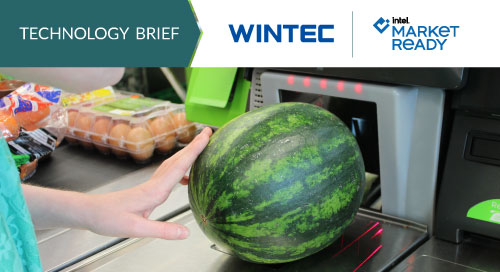Fill form to unlock content
Error - something went wrong!
Your content is just a step away. Please submit below.
Thank you!
AI Self-Checkout Eases Retail Experience

It’s a Saturday afternoon and the grocery store is full of shoppers. Like any other busy store on the weekend, the checkout queues are long. The best option is to head to the self-checkout lane.
Why? Self-service registers make the checkout process easier, and the lines move faster. You can review the price of your items as you scan them. You can bag your groceries how you like. It feels like a mini victory during an otherwise routine errand.
But when it comes to non-packaged items, self-checkout can be a painstaking process. You must search for the item name on the display, or find the sticker on a piece of produce, and then manually enter it into the system. And what happens if the system doesn’t recognize the item, or you make a mistake in entering the code? You will have to wait for assistance.
That’s why retailers leverage innovative smart retail solutions, like making self-checkout even better. AI, computer vision, and cloud technologies work together to help solve the small nuisances that shoppers encounter to make big improvements to the in-store shopping experience.
Thanks to companies like Wintec, a provider of smart retail solutions, this possibility can be a reality.
“The self-service checkout option is great. So many shoppers prefer it because it saves them time—they can handle everything themselves. But there are still flaws in the existing systems that deter customers from using that option,” says Lu Xuefeng, General Manager of the AI Division at Wintec.
AI-Powered Solutions Account for Human Error
The manual weighing process relies on staff to accurately identify many types of goods—from peaches to watermelons—and find the corresponding product code. Unskilled staff may encounter problems like inputting the wrong code or taking too long to find it. This leads to significant delays in the weighing and labeling process. During peak retail hours, customers may have to wait in especially long queues.
On top of that, using manual scales means spending time training staff initially and when new products are added to the store. As produce varies seasonally or by market, training requirements can be high. And as labor costs continue to rise, operational costs increase as well.
This aspect of the checkout process is hard for staff, but even harder for customers. Today, CV and AI enhance image recognition capabilities at the register—offering a better customer experience and lower costs for retailers.
Created to help #retail stores realize #ImageRecognition and automated weighing of prepackaged foods, the Wintec Smart Weighing solution identifies, weighs, and prints price tags for items. @Wintec_China via @insightdottech
Cloud-Edge-AI Architecture Enhances Checkout Systems
Created to help retail stores realize image recognition and automated weighing of prepackaged foods, the Wintec Smart Weighing solution identifies, weighs, and prints price tags for items. And through continued CV-enabled model training, it also provides high levels of detection accuracy.
The solution enhances image recognition through powerful edge-to-cloud computing. The software is trained for inference and real-time data processing, coordinated with cloud-based image model training using the YOLOv3 algorithm. This algorithm uses machine learning to achieve target recognition of fresh-food images by converting the task into a regression problem.
During the subsequent filtering process, the appropriate bounding box will be selected. By integrating object detection and object localization into a single one-stage network, YOLOv3 significantly increases detection speed.
“We created the solution to fix the hassle of manually inputting information for non-packaged items. But we weren’t focused on just that aspect,” says Xuefeng. “We wanted to create something that would continue to get smarter as it received more data. We also wanted to be able to take that data and make it available to retailers so they could gain useful insights from it for their overall operations.”
For instance, the solution integrates weighing functionality into the payment terminal, allowing customers to check out without visiting a weighing station. And eliminating the need for barcode readers helps reduce labor costs and expenses incurred from the maintenance and replacement of equipment.
Powerful Hardware and Software for Smart Retail Solutions
The Wintec Smart Weighing solution is built on Intel® processors, which provide powerful computing performance, safety, and reliability at low power consumption. These capabilities are essential for running edge AI workloads. The system also uses the Intel® OpenVINO™ toolkit to help with optimizing image recognition applications.
This is particularly useful in providing retailers with the ability to automate their entire business from the selection of goods to the weighing and checkout. Beyond that, real-time data processing provides actionable insights that help inform and facilitate business decisions in areas of operations beyond checkout.
The Future of Retail Automation
With transformative technologies and solutions available to the retail industry, the possibilities are almost endless.
As AI and automation technology continues to evolve, they can be implemented for the retail market segment beyond supermarkets and grocery stores. While requirements may differ based on format and application scenarios, tailored AI solutions have huge potential.
Grocery stores and other retail businesses are undergoing digital transformation. AI self-checkout is just one way retailers can improve customer satisfaction, increase competitiveness, and grow profits.
This article was edited by Christina Cardoza, Associate Editorial Director for insight.tech.
This article was originally published on July 14, 2022.